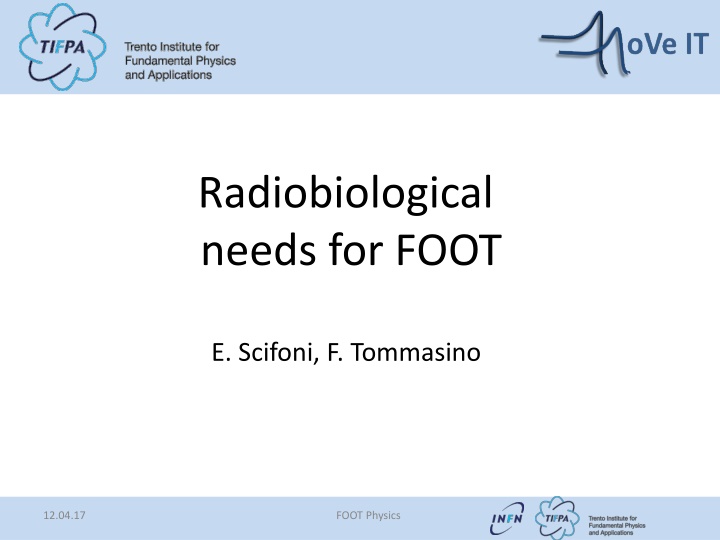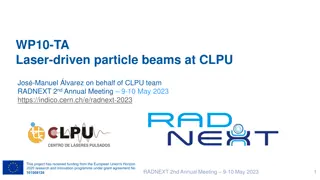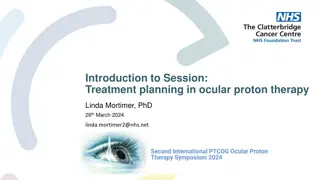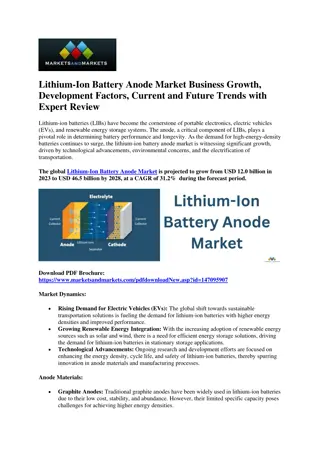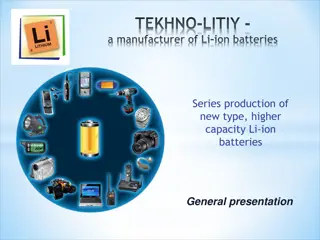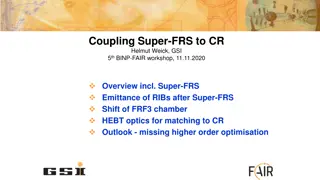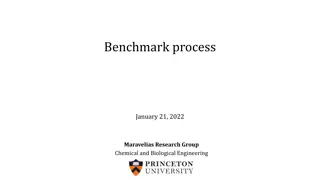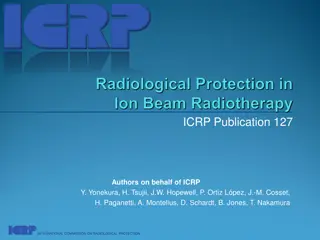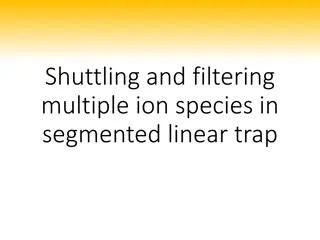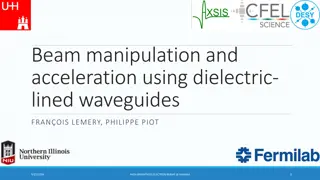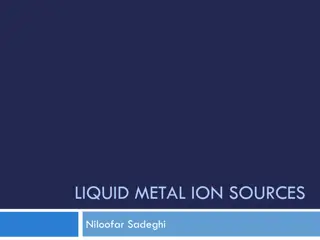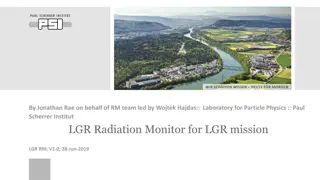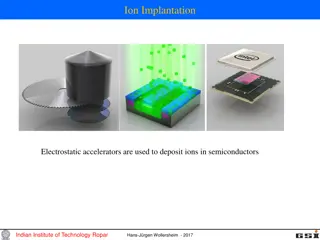Advancements in Biological Treatment Planning for Ion Beams
Exploring the integration of biological effect information in treatment planning for ion beams, this collection of research discusses the importance of proper data accounting for enhanced patient-specific planning and beam selection. Topics include radiobiological needs, target and projectile fragments in beam irradiation, modeling for ion beam treatment planning, and assessment of bio impact in experimental design.
Download Presentation

Please find below an Image/Link to download the presentation.
The content on the website is provided AS IS for your information and personal use only. It may not be sold, licensed, or shared on other websites without obtaining consent from the author.If you encounter any issues during the download, it is possible that the publisher has removed the file from their server.
You are allowed to download the files provided on this website for personal or commercial use, subject to the condition that they are used lawfully. All files are the property of their respective owners.
The content on the website is provided AS IS for your information and personal use only. It may not be sold, licensed, or shared on other websites without obtaining consent from the author.
E N D
Presentation Transcript
Radiobiological needs for FOOT E. Scifoni, F. Tommasino 12.04.17 FOOT Physics
Target Fragments in proton beam irradiation (inverse kin) Projectile Fragments in Oxygen beam irradiation (direct kin) 30.11.16 FOOT Meeting - Milano
oVe IT Modeling and Verification for Ion beam Treatment planning Giorgio Russo (LNS) Pablo Cirrone (LNS) Sebastian Hild (TIFPA) MG Pugliese (NA) WP3 WP1 WP4 WP2 Biological Dosimetry RB modeling for TPS Facilities NTCP/TCP T3.1: Devices for spatially resolved proton RBE measurement T2.1: NTCP models on proton patient data including RBE T4.1: CNAO/TIFPA/LNS lines development for beam delivering T1.1: RBE modeling for protons T4.2: MC Simulations for beamlines/target stations for in vitro/in vivo exp T3.2: Hypoxic, Coculture and Stem cells devices T2.2: TCP/NTCP including hypoxia for different ions T1.2: OER and ITH modeling T4.3: Detectors for beam flux and beam energy measurement T3.3: In vivo and Molecular biomarkers WP0 Coordination& Dissemination Emanuele Scifoni (TIFPA) 01.02.17 E. Scifoni-RDH Meeting
Interaction with INFN projects Fragment spectra FLUKA/GEANT4 tools for beamline description FOOT MoVeIT MC-INFN (CSN III) Assessment of bio impact and input for experimental design Radiobiological models for plan recalculation + Feed from previous related projects: TPS, RDH, UFSD 12.04.17 FOOT Physics
TRiP98 Biological Based Treatment planning for Particles Clinical use in pilot project, Research use in GSI, HIT, Aarhus, Lyon etc. Reference for: Siemens SynGo/PT, RaySearch Schardt et al. Rev Mod Phys 2010 Tinganelli et al. Sci.Rep.2015 OER Kraemer et al. EPJD 2014 01.02.17 E. Scifoni-RDH Meeting pO2 LET
Biological-based treatment planning Bio-TPS for ion beams aims to include as much as possible biological effect information in the planning strategy. Relevant for plan recalculation but ideally needed for inverse planning. Substantial for assessing differential benefits of different irradiation modalities and selecting the most suitable choice for a given patient case. Additional physics data needed, since the different components (E,Z) of the mixed field in a beam should be properly accounted in order to get an overall biological effect. 12.04.17 FOOT Physics
SHIELD-HIT (MC) + TRiP98 C beam 20% in xs => only 3% in RBE 12.04.17 FOOT Physics
Role of Target fragmentation in proton therapy Differently from Projectile fragments, their Energy distribution being peaked at very low E Combines with the peak of RBE at low E Heavy fragments have low residual energies and release low doses -> high RBE Tommasino & Durante 2015 Cancers 12.04.17 FOOT Physics
16O beam in TRiP Yield of secondary particles with depth in water for 16O at 160 MeV/u (TRiP98) - Large number of fragments - Few available experimental data - New data for full spectral characterization needed to assess impact of fragments are highly Exp attenuation data courtesy of C. La Tessa (BNL) 12.04.17 FOOT Physics
Exploiting O beams for hypoxia Scifoni et al PMB 2013 Submitted to PMB 12.04.17 FOOT Physics
OER-driven optimization: kill-painting approach Kill-painting approach: restoring a uniform survival inside the target, considering its non-uniform oxygenation including explicitly into optimization OER optimized plans with O (kill painting) LET-painting! NIRS+GSI Tinganelli et.al. Scientific Reports 2015 12C, 6 cm target (16 cm phantom) Variable oxygenation Survival Normoxic Sokol et al. submitted to PMB - In case of hypoxia, proper optimization accounting for OER may lead to Inverted peak-to- entrance ratios as compared to a normoxic case - According to actual oxygenation, O beam may overcome the price of larger entrance channel with the LET advantages - Trade-off between better LET distribution and worse Fragmentation in entrance and tail 12.04.17 FOOT Physics
Impact of high fragments Survival profile (CHO) along an O beam SOBP, optimized on physical flat (4Gy) dose 12.04.17 FOOT Physics
Desiderata for Protons Target fragment producton, at 100-200 MeV: Heavy fragment (Z>2) production cross section with uncertainty < 5% Fragment energy spectrum (i.e. d /dE) with energy resolution of 1 MeV/u Charge ID at the level of 2-3% Isotopic ID at the level of 5% Not needed accurate angular measurement Study light ions production at large angle 12.04.17 FOOT Physics
Desiderata for Oxygen Projectile Fragment producton, at 150-400 MeV/u: Cross section of projectile fragments with maximum uncertainty of 5-10% Fragment energy spectrum (i.e. d /dE) with an energy resolution of 10 MeV/u Charge ID at the level of 2-3% Isotopic ID at the level of 5% Angular distribution needed for out-of-field biological dose 12.04.17 FOOT Physics
Our strategy for better figures design MC Spectra from WP4 (LNS-GEANT4, MILANO-FLUKA) 2 options: Voxelized (layered) Spectra dN/dE(Z,z,E,E0) including eventual buidup Pure Fragment Spectra dN/dE(Z,E,E0) -> YIELD-> TRiP98 12.04.17 FOOT Physics
Parallel approaches for T_frag impact assessment Track structure simulations of low energy ions -with no Energy/space cutoff in secondary electrons- TRAX GEANT4DNA 12.04.17 FOOT Physics
Milestones related to FOOT Milestone M1.1.1 Description Date Initial RBE description with tentative cross sections Final RBE description with FOOT cross sections November 2017 M1.1.2 July 2019 M2.1.2 Comparison between proton NTCP estimations November 2019 M2.2.1 NTCP/TCP estimations with different ions, on imported plans April 2019 12.04.17 FOOT Physics
Thank you He H O C 12.04.17 FOOT Physics
